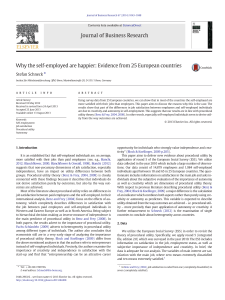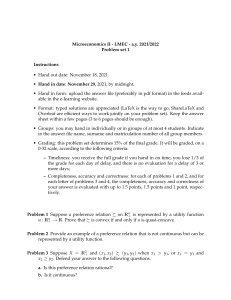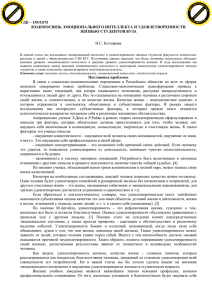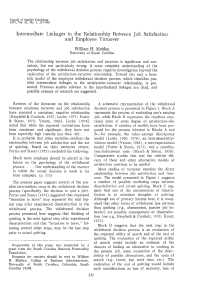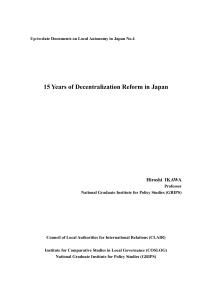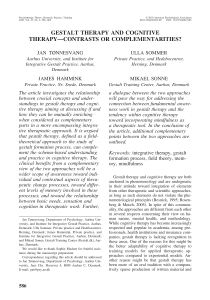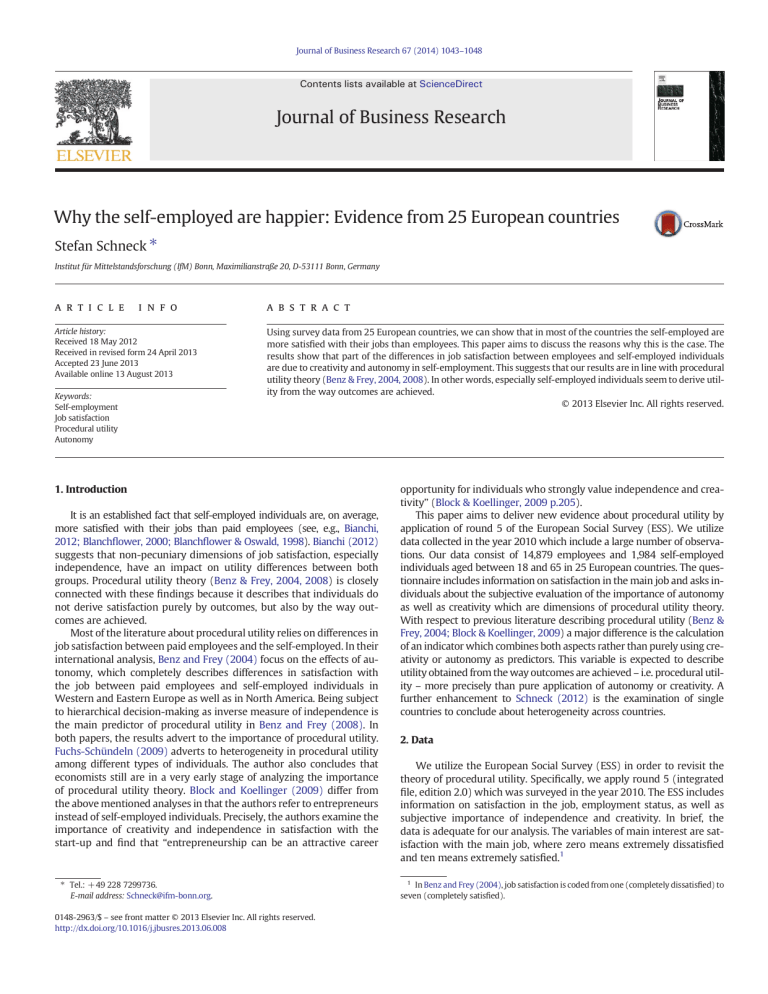
Journal of Business Research 67 (2014) 1043–1048 Contents lists available at ScienceDirect Journal of Business Research Why the self-employed are happier: Evidence from 25 European countries Stefan Schneck ⁎ Institut für Mittelstandsforschung (IfM) Bonn, Maximilianstraße 20, D-53111 Bonn, Germany a r t i c l e i n f o Article history: Received 18 May 2012 Received in revised form 24 April 2013 Accepted 23 June 2013 Available online 13 August 2013 Keywords: Self-employment Job satisfaction Procedural utility Autonomy a b s t r a c t Using survey data from 25 European countries, we can show that in most of the countries the self-employed are more satisfied with their jobs than employees. This paper aims to discuss the reasons why this is the case. The results show that part of the differences in job satisfaction between employees and self-employed individuals are due to creativity and autonomy in self-employment. This suggests that our results are in line with procedural utility theory (Benz & Frey, 2004, 2008). In other words, especially self-employed individuals seem to derive utility from the way outcomes are achieved. © 2013 Elsevier Inc. All rights reserved. 1. Introduction It is an established fact that self-employed individuals are, on average, more satisfied with their jobs than paid employees (see, e.g., Bianchi, 2012; Blanchflower, 2000; Blanchflower & Oswald, 1998). Bianchi (2012) suggests that non-pecuniary dimensions of job satisfaction, especially independence, have an impact on utility differences between both groups. Procedural utility theory (Benz & Frey, 2004, 2008) is closely connected with these findings because it describes that individuals do not derive satisfaction purely by outcomes, but also by the way outcomes are achieved. Most of the literature about procedural utility relies on differences in job satisfaction between paid employees and the self-employed. In their international analysis, Benz and Frey (2004) focus on the effects of autonomy, which completely describes differences in satisfaction with the job between paid employees and self-employed individuals in Western and Eastern Europe as well as in North America. Being subject to hierarchical decision-making as inverse measure of independence is the main predictor of procedural utility in Benz and Frey (2008). In both papers, the results advert to the importance of procedural utility. Fuchs-Schündeln (2009) adverts to heterogeneity in procedural utility among different types of individuals. The author also concludes that economists still are in a very early stage of analyzing the importance of procedural utility theory. Block and Koellinger (2009) differ from the above mentioned analyses in that the authors refer to entrepreneurs instead of self-employed individuals. Precisely, the authors examine the importance of creativity and independence in satisfaction with the start-up and find that “entrepreneurship can be an attractive career ⁎ Tel.: +49 228 7299736. E-mail address: Schneck@ifm-bonn.org. 0148-2963/$ – see front matter © 2013 Elsevier Inc. All rights reserved. http://dx.doi.org/10.1016/j.jbusres.2013.06.008 opportunity for individuals who strongly value independence and creativity” (Block & Koellinger, 2009 p.205). This paper aims to deliver new evidence about procedural utility by application of round 5 of the European Social Survey (ESS). We utilize data collected in the year 2010 which include a large number of observations. Our data consist of 14,879 employees and 1,984 self-employed individuals aged between 18 and 65 in 25 European countries. The questionnaire includes information on satisfaction in the main job and asks individuals about the subjective evaluation of the importance of autonomy as well as creativity which are dimensions of procedural utility theory. With respect to previous literature describing procedural utility (Benz & Frey, 2004; Block & Koellinger, 2009) a major difference is the calculation of an indicator which combines both aspects rather than purely using creativity or autonomy as predictors. This variable is expected to describe utility obtained from the way outcomes are achieved – i.e. procedural utility – more precisely than pure application of autonomy or creativity. A further enhancement to Schneck (2012) is the examination of single countries to conclude about heterogeneity across countries. 2. Data We utilize the European Social Survey (ESS) in order to revisit the theory of procedural utility. Specifically, we apply round 5 (integrated file, edition 2.0) which was surveyed in the year 2010. The ESS includes information on satisfaction in the job, employment status, as well as subjective importance of independence and creativity. In brief, the data is adequate for our analysis. The variables of main interest are satisfaction with the main job, where zero means extremely dissatisfied and ten means extremely satisfied.1 1 In Benz and Frey (2004), job satisfaction is coded from one (completely dissatisfied) to seven (completely satisfied). 1044 S. Schneck / Journal of Business Research 67 (2014) 1043–1048 The indicators for procedural utility differ somewhat from the ones applied in Benz and Frey (2004). Our measures refer to: • Thinking up new ideas and being creative is important to her/him. She/he likes to do things in her/his own original way. In the following referred to as creativity. • It is important to her/him to make her/his own decisions about what she/he does. She/he likes to be free and not depend on others.2 Henceforth abbreviated as autonomy. Original data is based on a Likert-scale from one to six, whereas value one indicates “very much like me” and value six means “Not like me at all”. In the following analysis, we recode this information with the result that value one describes “Not like me at all” and value six corresponds to “Very much like me”. This variable, then, presents an ordinal indicator for procedural utility, whereas higher values imply higher identification with autonomy or creativity. In addition, we also generate the mean of the combination of autonomy and creativity as Þ . Table 1 displays means and standard follows: autocreat ¼ ðautonomyþcreativity 2 deviations of the main variables of interest. The Table reveals positive relationships between job satisfaction and our measures of autonomy, creativity, and autocreat. This suggests that individuals with a high taste for autonomy are more satisfied in their job. We also calculated pairwise correlation coefficients for the selfemployed and for the paid employees separately (see Table 2). The highly significant and positive relationship is observed for both subgroups as well. This implies that self-employed as well as paid employees seem to be more satisfied in their jobs when autonomy or creativity is high. The effects, however, are slightly larger for the self-employed. Self-employment is measured by a dummy variable, where value one means self-employment and zero describes paid employment. Our empirical methodology is similar to the one applied in Benz and Frey (2004) and Schneck (2012). We account for the ordinal nature of the job satisfaction variable via an ordered logit model. The set of control variables is standard in studies on (job) satisfaction and procedural utility. It includes gender, partner, household's net income, age (squared), working time (squared), and education (ISCED codes). Information about generation and coding can be found online (http://ess.nsd.uib.no/ess/ round5/) in the freely available survey documentation files and in the fieldwork documents.3 The corresponding descriptive statistics can be found in Table A1. Another similarity with Benz and Frey (2004), and Block and Koellinger (2009), and Schneck (2012) is that we compare the effects of the dummy variable describing self-employment across specifications in order to conclude about the impact of procedural utility in self-employment. In this line we conduct the baseline ordered logit regression without controlling for procedural utility. Then, we extend the baseline specification by i) autonomy, ii) creativity, iii) autonomy as well as creativity, and finally by iv) autocreat. Autonomy and creativity are significantly correlated, but problems regarding multicollinearity seem not to be evident (see Table 1). Also the country-specific examination does not provide any signs for such a problem because the highest pairwise correlation equals 0.446 in Ireland.4 3. Results Table 3 presents the average job satisfaction for employees and for the self-employed in columns 2 and 3.5 In most of the countries, self- 2 See Appendix A6, Variables and questions, ESS5-2010 ed. 2.0 on http://ess.nsd.uib.no/ ess/round5/ (01.05.2012); questions Ha and Hk. 3 More detailed ISCED codes are available in the original data, which are aggregated to six classes here. 4 Results are not presented here (available upon request). 5 Note that there are only few observations in some countries. Less than 50 selfemployed are observed in Croatia, Hungary, the Russian Federation, Slovenia, and Ukraine. Table 1 Pairwise correlation. Job satisfaction Autonomya a Creativity autocreat Number of observations Mean (std. deviation) Job satisfaction 7.363 (1.935) 4.844 (1.063) 4.518 (1.191) 4.681 (0.909) 16,863 1.000 Autonomy Creativity 0.0635⁎⁎⁎ 1.000 0.103⁎⁎⁎ 0.298⁎⁎⁎ 1.000 0.105⁎⁎⁎ 0.780⁎⁎⁎ 0.830⁎⁎⁎ autocreat 1.000 a 1 “Not like me at all”; 6 “Very much like me”. ⁎⁎⁎ p b 0.01, ⁎⁎ p b 0.05, ⁎ p b 0.1. employed individuals are more satisfied with their job than employees. This result is basically in line with the literature (see, e.g., Bianchi, 2012; Blanchflower, 2000; Blanchflower & Oswald, 1998). Exceptions are Greece and Bulgaria where employees are, on average, 0.210 and 0.038 points more satisfied than the self-employed. This difference, however, is only small in magnitude and t-tests suggest no significance. The self-employed, in turn, are, on average, significantly more satisfied in Western Europe, Eastern Europe, and in other countries.6 Columns 4 to 8 in Table 3 show the results for the ordered logit model with job satisfaction as dependent variable. All displayed coefficients are to interpret when holding the control variables constant. At first, we discuss the results of the baseline specification in column 4. The dummy variable for self-employment is significantly positive in Western Europe, Eastern Europe, and the other countries. The results for Western as well as for Eastern Europe and Cyprus are also in line with the ones presented in Benz and Frey (2004). This indicates that the self-employed are, on average, more satisfied with their jobs in these regions even after controlling for a variety of variables including working hours and household income. This general conclusion only holds at first glance because the country-specific examination reveals that the coefficient for self-employment is significantly positive only in 15 of 25 countries. Also note that the examination by country reveals that, ceteris paribus, the self-employed in Greece, Norway, Bulgaria, and Ukraine are insignificantly less satisfied than their employed counterparts. These findings suggest that there is some degree of heterogeneity across countries and that examination for each country separately might yield deeper insights than consideration of aggregate regions as in Schneck (2012) or Benz and Frey (2004). In column 5 of Table 3, the baseline regression is enhanced by the indicator for autonomy. The coefficients for the dummy variable for selfemployment decrease in size in the aggregate regions (also see Schneck, 2012), which implies that autonomy explains part of the higher job satisfaction for the self-employed. This is to interpret as evidence in favor of procedural utility theory. Autonomy, however, only explains part of the higher job satisfaction of the self-employed because the dummy variable describing self-employment remains significantly positive for Western and Eastern Europe as well as other regions. In Benz and Frey (2004) the autonomy indicator fully explains differences in job satisfaction between employees and self-employed individuals because the coefficient of self-employment becomes insignificant after inclusion of the corresponding indicator in Western and Eastern Europe. 6 Note that Italy and Portugal are examined in Benz and Frey (2004), but cannot be considered here. S. Schneck / Journal of Business Research 67 (2014) 1043–1048 Table 2 Pairwise correlation for paid employees and self-employed separately. Job satisfaction Job satisfaction Autonomya a Creativity autocreat Number of observations 1.000 1.000 0.0513⁎⁎⁎ 0.0876⁎⁎⁎ 0.0923⁎⁎⁎ 0.1147⁎⁎⁎ 0.0908⁎⁎⁎ Autonomy Creativity autocreat 1.000 1.000 0.2880⁎⁎⁎ 0.3030⁎⁎⁎ 0.7768⁎⁎⁎ 0.7815⁎⁎⁎ 1.000 1.000 0.8268⁎⁎⁎ 0.8268⁎⁎⁎ 1.000 1.000 0.1261⁎⁎⁎ 14,879 paid employees 1,984 self-employed First line: Correlations for the paid employees Second line: Correlations for the self-employed a 1 “Not like me at all”; 6 “Very much like me”. ⁎⁎⁎ p b 0.01, ** p b 0.05, * p b 0.1. Examination by country reveals that a significant and positive effect of independence is estimated in eleven of 25 countries. Note that in France, Switzerland, Croatia, and Estonia we find evidence that the autonomy variable exhibits negative impact on satisfaction. In this line, the coefficients for the dummy variable for self-employment increased in size when compared to the baseline specifications in these countries. As a result, the individual evaluation of autonomy does not provide an explanation for differences for the greater job satisfaction of the self-employed. In addition, our result for Switzerland is not in line with the findings of Benz and Frey (2008) who show that dissatisfaction with hierarchy – as an inverse measure of autonomy – is substantial and in favor for procedural utility theory. For Great Britain, we also find much weaker effects than the ones presented in Benz and Frey (2008). The findings for Germany corroborate a weak effect of procedural utility as also found in Benz and Frey (2008) for West Germany. In sum, our results suggest that there is some heterogeneity regarding procedural utility across regions in Western and Eastern Europe. In a next step, we examine the effect of subjective importance of individuals who like to do things in an own original way in column 6 of Table 3 on procedural utility. Again, the coefficients for self-employment decrease for Western Europe, Eastern Europe, and other countries when compared with the baseline specification. Moreover, the corresponding decrease in job satisfaction is larger when compared with the specification including autonomy. In France, Switzerland, and Croatia the coefficient of self-employment, now, decreases in size when compared to the baseline specification. This corroborates that part of the differences in satisfaction of paid employees and self-employed are due to differences in creativity. In contradiction, the coefficient of self-employment is increasing in Estonia after inclusion of creativity. The effect of our creativityindicator, furthermore, is significantly positive in 15 of 25 countries and negative only for Estonia. In brief, these findings suggests that creativity and the taste for doing things in an original way seem to explain more of the difference in job satisfaction between the selfemployed and employees when compared with autonomy. In the case of Spain, the inclusion of this variable fully explains the differential in job satisfaction of self-employed and employed individuals; when entering this variable into regression, the coefficient for selfemployed is not statistically different from zero any more. Again, we find support for the theory that individuals value conditions and processes leading to outcomes. In the following, we enhance the baseline model by both, creativity and autonomy (column 7 of Table 3). Note that, again, procedural utility fully explains differences in job satisfaction between employees and self-employed individuals in Spain. Similar effects, now, are also evident for Israel and Cyprus together. For Switzerland and Estonia, in contradiction, the coefficient for self-employment is larger than in the baseline 1045 specification. In addition, Slovenia extends the set of countries where the coefficient of self-employment increases after inclusion of the autonomy and creativity variables. Inclusion of both indicators also seems to counteract the effects of pure consideration of autonomy in some countries. This is the case in Belgium, Denmark, and Slovenia, where the coefficient of self-employment is larger in size than in column 4. Finally, our generated variable autocreat is accounted for in column 8 of Table 3. For Switzerland, Estonia, and Slovenia, again, our indicator suggests that the dummy variable for self-employment increases in size when compared to the baseline specification. In fact, only the specification including creativity suggests that the way outcomes are achieved is of importance in Switzerland. For Spain and other countries, the combination of autonomy and creativity corroborates that procedural utility seems to help to explain differences in job satisfaction completely. In sum, the results shown in Table 3 reveal evidence in favor of procedural utility theory for 16 of 25 countries. The results are not robust to different specifications in France, Switzerland, Croatia, and Slovenia. All specifications provide evidence against procedural utility theory in Estonia. In addition, our estimation results suggest that employees are more satisfied with their jobs than the selfemployed in Greece, Norway, Bulgaria, and in Ukraine. We do not overemphasize negative coefficients for self-employment because they are insignificant in all of the specifications with exception of Bulgaria when applying autocreat. In this case, inclusion of the indicator of procedural utility leads to a significant difference in job satisfaction, where employees are more satisfied than individuals in self-employment. These findings suggest that procedural utility is an important strand in the literature to explain why the selfemployed are more satisfied with their jobs than employees, but there is some heterogeneity across countries. A major shortcoming of this paper is that it only examines the round 5 of the ESS. Panel data would be needed to gain further insights about the developments of procedural utility over time. Note that the main questions are also asked in round 3 of the ESS survey. There are, however, crucial differences in the way some control variables are measured. The household's net income variable, for example, is generated in a different way as the categories do not refer to country-specific income percentiles, but to given intervals which are equal across countries. Interpretation of results obtained at the different points in time, thus, becomes more complex and is not straightforward because differences might be contributed to changes in the measurement of this control variable. Furthermore, income information in Estonia, Hungary, Romania, and Ukraine have been omitted from the international file because of different income categories (Bulgaria, Hungary, and Romania) or was asked without showcards for the different categories (Estonia). As Bulgaria, Estonia, and Hungary are included into the current analysis, we are not able to compare data and results of round 3 with the ones of round 5. 4. Conclusion The paper shows that the self-employed are, on average, more satisfied with their jobs when compared with paid employees in 23 of 25 European countries. Only the self-employed in Greece and Bulgaria are marginally less satisfied than their employed counterparts. Our data, thus, is largely in line with the literature on job satisfaction and selfemployment (see, e.g., Bianchi, 2012; Blanchflower, 2000; Blanchflower & Oswald, 1998). After controlling for, among others, household income and working time also the self-employed in Ukraine and Norway are insignificantly less satisfied than paid employees. This paper also contributes new evidence to procedural utility theory. The majority of estimates suggest that the way outcomes are achieved explains an important part of the difference in job satisfaction between paid employees and the self-employed. We, 1046 S. Schneck / Journal of Business Research 67 (2014) 1043–1048 Table 3 Satisfaction with main job and results on procedural utility. Mean satisfaction with main job (observations) Estimated coefficients for dummy variable describing self-employmenta (robust std. errors) Country Employees Self-employed Baseline specification Including “autonomy” Including “creativity” Including “autonomy” and “creativity” Including “autocreat” Western Europeb 7.558 (8,672) 7.870 (1,318) 0.434*** (0.0617) 0.414*** (0.0618) +++ 0.393*** (0.0619) 0.385*** (0.0619) Belgiumc 7.753 (627) 8.088 (80) 0.362 (0.283) 0.329 (0.286) 0 Denmark 8.149 (656) 8.671 (73) 0.515** (0.240) 0.463* (0.243) 0 0.385*** (0.0619) + +++ 0.330 (0.285) 0 0 0.467* (0.243) 0 0 0.795*** (0.234) 0 0 0.651** (0.258) − 0 0.239 (0.206) 0 0 0.498** (0.210) − +++ −0.289 (0.209) 0 0 c Finland 7.685 (631) 8.257 (113) 0.819*** (0.230) 0.800*** (0.229) 0 France 7.362 (732) 7.960 (75) 0.681*** (0.250) 0.698*** (0.254) − Germany 7.458 (1,066) 7.722 (126) 0.272 (0.205) 0.250 (0.205) 0 Great Britain 7.179 (804) 7.752 (121) 0.568*** (0.212) 0.563*** (0.212) 0 Greece 6.775 (435) 6.565 (168) −0.232 (0.206) −0.262 (0.207) ++ Italy Irelandc no observations 7.127 (471) 7.639 (83) 0.239 (0.253) 0.186 (0.255) +++ Netherlandsc 7.586 (650) 8.211 (95) 0.835*** (0.277) 0.792*** (0.278) ++ +++ 0.353 (0.283) + 0.502** (0.239) 0 0.803*** (0.234) 0 0.632** (0.255) 0 0.251 (0.206) 0 0.486** (0.211) +++ −0.278 (0.208) ++ 7.969 (64) −0.0223 (0.330) −0.0236 (0.330) 0 Norway 7.927 (809) Portugal Spainc No observations 7.502 (554) 7.800 (125) 0.384* (0.205) 0.367* (0.204) 0 Sweden 7.541 (638) 8.346 (104) 0.994*** (0.215) 0.967*** (0.216) 0 Switzerland 7.955 (599) 8.593 (91) 0.777*** (0.231) 0.791*** (0.233) − 6.889 (5,379) 7.624 (537) 0.638*** (0.0843) 0.591*** (0.0846) +++ 0.207 (0.255) +++ 0.821*** (0.278) 0 −0.0626 (0.332) ++ Eastern Europeb Bulgaria 6.788 (608) 6.750 (52) −0.235 (0.271) −0.320 (0.277) + Croatiac 6.625 (339) 8.219 (32) 1.473*** (0.368) 1.498*** (0.385) +++ 0.330 (0.204) +++ 0.959*** (0.215) 0 0.767*** (0.232) 0 0.586*** (0.0842) +++ −0.419 (0.260) +++ 1.412*** (0.368) 0 0.178 (0.256) ++ ++ 0.791*** (0.278) ++ 0 −0.0596 (0.332) − ++ 0.320 (0.204) 0 +++ 0.942*** (0.216) 0 0 0.780*** (0.233) − 0 0.564*** (0.0844) +++ +++ −0.418 (0.266) − +++ 1.452*** (0.384) ++ 0 +++ 0.329 (0.285) + 0.463* (0.240) 0 0.784*** (0.232) 0 0.660*** (0.255) 0 0.237 (0.206) + 0.496** (0.211) +++ −0.288 (0.209) +++ 0.180 (0.256) +++ 0.794*** (0.277) *0 −0.0536 (0.330) 0 0.323 (0.203) +++ 0.943*** (0.216) 0 0.778*** (0.234) − 0.559*** (0.0843) +++ −0.459* (0.267) +++ 1.412*** (0.372) +++ S. Schneck / Journal of Business Research 67 (2014) 1043–1048 1047 Table 3 (continued) Mean satisfaction with main job (observations) Estimated coefficients for dummy variable describing self-employmenta (robust std. errors) Employees Self-employed Baseline specification Including “autonomy” Including “creativity” Including “autonomy” and “creativity” Including “autocreat” Czech Republic 6.638 (687) 7.412 (97) 0.675*** (0.214) 0.590*** (0.217) ++ 0.611*** (0.217) 0.562*** (0.217) Estoniac 7.129 (622) 7.933 (60) 0.987*** (0.258) 1.041*** (0.265) − Hungary 7.105 (485) 8.000 (40) 0.736** (0.318) 0.634** (0.317) + 0.566*** (0.218) + ++ 1.034*** (0.266) − 0 0.596* (0.315) 0 ++ 0.202 (0.233) 0 0 1.261*** (0.267) ++ + 1.088*** (0.313) 0 +++ 0.486 (0.378) + +++ −0.204 (0.341) 0 0 0.284 (0.175) +++ +++ 0.413* (0.226) 0 +++ 0.264 (0.289) +++ ++ Country Poland 7.259 (528) 7.531 (81) 0.233 (0.227) 0.212 (0.231) 0 6.621 (878) 8.286 (35) 1.305*** (0.272) 1.276*** (0.272) ++ Slovakiac 6.951 (405) 8.041 (73) 1.132*** (0.302) 1.110*** (0.301) 0 Slovenia 7.349 (398) 7.531 (32) 0.485 (0.393) 0.484 (0.390) ++ Ukrainec 6.655 (429) 6.771 (35) −0.111 (0.336) −0.212 (0.338) ++ 7.345 (828) 7.868 (129) 0.375** (0.175) 0.314* (0.176) +++ 7.654 (257) 8.031 (64) 0.485** (0.221) 0.463** (0.222) 0 Russian Federation Other countries Cyprusb b Israel 7.207 (571) 7.708 (65) 0.371 (0.296) 0.282 (0.295) +++ +++ 0.991*** (0.261) − 0.649** (0.316) +++ 0.214 (0.231) 0 1.279*** (0.266) ++ 1.091*** (0.314) +++ 0.485 (0.375) +++ −0.137 (0.342) ++ 0.320* (0.173) +++ 0.414* (0.226) +++ 0.327 (0.288) +++ +++ 1.023*** (0.265) − 0.581* (0.312) +++ 0.201 (0.233) 0 1.261*** (0.267) +++ 1.066*** (0.307) +++ 0.486 (0.379) +++ −0.191 (0.343) +++ 0.284 (0.174) +++ 0.418* (0.227) +++ 0.271 (0.286) +++ Control variables: gender (male = 1), partner (lives with husband/wife/partner = 1), percentile of household income, age, age squared, hours worked (hours you do/did normally work a week (in your main job), including any paid or unpaid overtime), hours worked squared, education (ISCED-codes), regional dummy variables. Significance level for coefficient for self-employed: ***p b 0.01, **p b 0.05, *p b 0.1. Coefficient for procedural utility: positive coefficient: +++p b 0.01, ++p b 0.05, +p b 0.1. positive coefficient: 0 p N 0.1. negative coefficient (significant or insignificant): −. Importance to be free: ordinal Likert-scale from 1 to 6. Like to do things in own original way: ordinal Likert-scale from 1 to 6. Robust standard errors in parentheses. a Ordered logit model: Self-employment = 1; employee = 0. b The first five columns are identical to Schneck (2012). c Countries not included in Benz and Frey (2004). however, cannot confirm that procedural utility frequently explains the difference in job satisfaction completely as suggested in Benz and Frey (2004). In fact, we can corroborate this only for Spain and when pooling observations for Cyprus and Israel. In addition, the results advert to some heterogeneity across countries. In sum, 16 of 25 European countries reveal evidence in favor of the theory that individuals derive utility from the way outcomes are achieved. Finally, we find no evidence in favor of procedural utility theory in Estonia. The differences in the results between this paper and the ones in Benz and Frey (2004) might partly be attributed to differences in the indicators for procedural utility. Benz and Frey (2004) might apply a more reliable job-independence indicator because the authors refer to the self-assessment of “I can work independently”. Our indicators for procedural utility, in turn, refer to the individual self-assessment in general life. With respect to procedural utility, our central variables indicate how individuals value autonomy or creativity, but not how independent they can work in their job. It might, however, be presumed that our indicators for procedural utility directly affect satisfaction with the job and, thus, contribute further explanation to the question why the self-employed are happier. 1048 S. Schneck / Journal of Business Research 67 (2014) 1043–1048 Appendix A Table A1 Descriptive statistics. Variable Mean Std. Deviation Dummy variable describing self-employment Male Living together with partner Country-specific household's net income percentile 1 Country-specific household's net income percentile 2 Country-specific household's net income percentile 3 Country-specific household's net income percentile 4 Country-specific household's net income percentile 5 Country-specific household's net income percentile 6 Country-specific household's net income percentile 7 Country-specific household's net income percentile 8 Country-specific household's net income percentile 9 Country-specific household's net income percentile 10 Age Age squared Total hours worked (incl. overtime) Total hours worked (incl. overtime) squared ISCED 1 ISCED 2 ISCED 3 ISCED 4 ISCED 5 ISCED 6 Number of observations 0.118 0.511 0.682 0.030 0.061 0.081 0.096 0.110 0.123 0.132 0.130 0.115 0.121 42.276 1914.313 41.044 1829.106 0.029 0.085 0.420 0.060 0.394 0.011 16,863 0.322 0.500 0.466 0.171 0.240 0.273 0.295 0.313 0.328 0.339 0.336 0.319 0.326 11.273 957.330 12.022 1112.373 0.169 0.279 0.494 0.238 0.489 0.103 Also see Schneck (2012). References Benz, M., & Frey, B.S. (2004). Being independent raises happiness at work. Swedish Economic Policy Review, 11, 95–134. Benz, M., & Frey, B.S. (2008). Being independent is a great thing: Subjective evaluations of self-employment and hierarchy. Economica, 75, 362–383. Bianchi, M. (2012). Financial development, entrepreneurship, and job satisfaction. The Review of Economics and Statistics, 94, 273–286. Blanchflower, D.G. (2000). Self-employment in OECD countries. Labour Economics, 7, 471–505. Blanchflower, D.G., & Oswald, A. J. (1998). What makes an entrepreneur? Journal of Labor Economics, 16, 26–60. Block, J., & Koellinger, P. (2009). I can't get no satisfaction—necessity entrepreneurship and procedural utility. Kyklos, 62, 191–209. Fuchs-Schündeln, N. (2009). On preferences for being self-employed. Journal of Economic Behavior & Organization, 71, 162–171. Schneck, S. (2012). Revisiting Procedural Utility: Evidence from European Survey Data. The Empirical Economics Letters, 11, 1275–1280.
